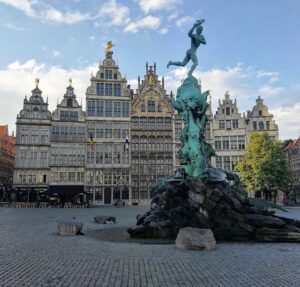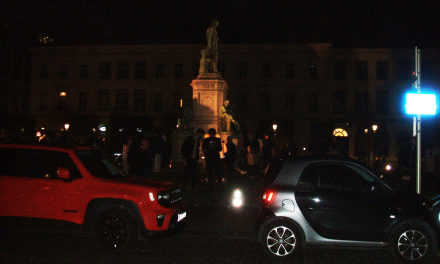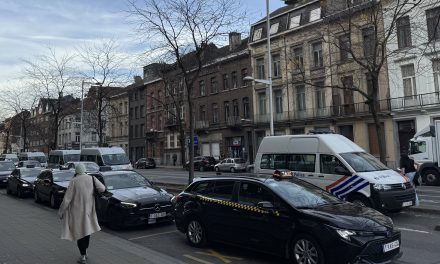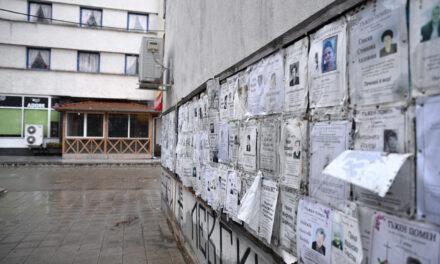In the past, there were certain customs, events, and traditions. These are maintained by the Sinjoren, the purebred Antwerpians. They tell the folk tales for those who can no longer do so or are no longer with us. The Sinjoren are a more discussed topic nowadays because few of them still exist. The media also refer to them as the ‘dying breed.’ I went to Antwerp to look in the beautiful city, and I spoke with one of these Sinjoren, who nevertheless no longer lives in Antwerp – but is still extremely involved in the Antwerp’ community.
Maria, a true Antwerpian in heart and soul, sits across from me. She has just made a nice pot of Earl Grey tea, poured two cups, and sat down. Her husband, Herman, is gardening in the beautiful large backyard they own together. Maria starts talking: “My parents were also both purebred Antwerpians and have lived there their whole lives, unlike me.” Maria moved to the Netherlands in 1999. When asked if she ever regretted it, she replied: “Regrets, never. But it is sometimes a pity when I, for example, speak to a good friend or my old neighbors from Antwerp. I call a lot with my sister, who still lives in Antwerp. Every week we discuss everything that happens in the city. Especially in times of Corona I have had a tough time. In the end, my emigration was a choice that I still support one hundred percent, but the loss is sometimes quite large.”
Although Maria has emigrated to the Netherlands, she feels like a real Sinjoor. “My father, my mother, my grandparents and even my great grandparents – all the way back to the Eighty Years’ War – were all real Sinjoren. They have lived there all their lives, worked, and raised their descendants. I met my husband in Antwerp, but he is a Dutchman. We lived in Antwerp for a while, with our daughters. But my husband’s family is much bigger than mine, and everyone from his side of the family lived in Alphen aan de Rijn. Finally, after twenty years, we decided to move back to the Netherland”. Although, it was hard for Maria in the beginning, getting used to an unfamiliar environment and new people around you, she can now see it all in perspective. “As a mother you ultimately choose your family, my husband’s family had much more prestige. My daughters were able to study in Amsterdam, in Antwerp that would never have been possible”, says Maria. Yet it hurts when Maria hears the stories about the extinction of the Sinjoren. Her children are not real Sinjoren, because they have a Dutch identity. “I knew that purebred Antwerpians were not so common anymore, but when you hear the word ‘extinction’ you think to yourself: ‘hey extinction? I am still here, aren’t I?’. You suddenly feel incredibly old when they describe you as a dying specie in the media – like a dinosaur.”
“Fortunately, the Sinjoren are not as old as the dinosaurs,” jokes Koen (history teacher). “But still the Sinjoren go way back. The time of the Sinjoren can be traced back to the Eighty Years’ War”, says Koen. Koen: “The Siege of Antwerp began on the third of July 1584 and lasted no less than fourteen months. Now the Siege of Antwerp is a topic that we discuss in high schools, and which is also part of the exam material. Yet little has been written about the Sinjoren in the history books we use at school. In response to your e-mail, I have delved into the Sinjoren, the story and any matching culture”. According to Koen, the Siege of Antwerp had a major influence on the prosperity and well-being of Antwerpians. “With the Siege of Antwerp came an end to the Golden Age in Antwerp, how well everyone had it (relatively speaking) at the time – there was nothing left of it after the Fall of Antwerp. I can imagine that this fourteen-month occupation has not been fun for the resident. With the disappearance of the Sinjoren, a piece of sadness and commemoration disappears – not even necessarily traditions or culture,” says Koen.
Maria takes a sip of her tea and looks outside. The weather is nice. Maria jokes: “That’s something that hasn’t changed, the weather. Belgium versus the Netherlands is the same,”. There is also spoken of the disappearance of city stories and old traditions. Maria: “About those traditions, that’s not entirely true. That there would be traditions associated with the existence of Sinjoren is nonsense. There are Belgian traditions, and of course Antwerp traditions. There are also slight differences in traditions per city region. But that traditions would be accompanied by the fact that you would be a Sinjoor is not true. The word Sinjoor comes from the Spanish word señor, which means ‘lord’. It’s really just a nickname – and not even a separate breed.”
But what is so bad about the disappearance of the Sinjoren? Maria: “The disappearance of the Sinjoren is not a disaster – the world will not get destroyed. But for the purebred Antwerpians it is a piece of history that disappears. In the Eighty Years’ war it was no fun for my (and many others) family. There is a bit of sadness, pride, and culture behind it. If that disappears, it will be painful for those who are purebred Antwerpians.” For now, the city stories continue to exist because of the many city guides who tell the old town stories during their tour. There are also historians and history literature that are up to date about the Sinjoren and the stories from the Eighty Years’ War.
Maria may no longer live in Antwerp and have been settled in the Netherlands for years. She hopes that – if she ends up in a nursing home – that will be in Antwerp. She also has a family grave in Antwerp, she will be buried with her parents at the Merksem Zwaantjeslei cemetery. Maria: “I think a lot of people don’t really care whether or not you’re a purebred Antwerpian. Nowadays everyone is equal, and most people no longer attach much value to history, which is more something of our generation.”
We drink another cup of tea, have a nice pastry, and end our conversation. Maria looks at her husband Herman who has been gardening all this time. I get up and pack my things to travel back home from Alphen aan de Rijn. Maria concludes with the words: “Whether or not the Sinjoren are dying out, I still feel very young at the age of 82 and hope not to belong to the dying breed that is portrayed in the media.”









